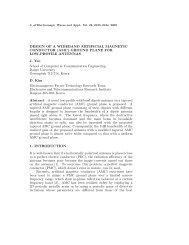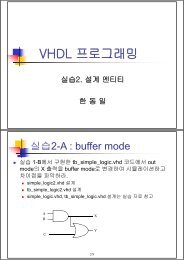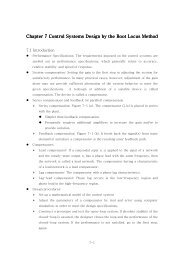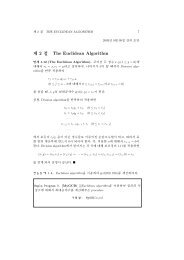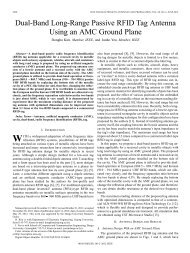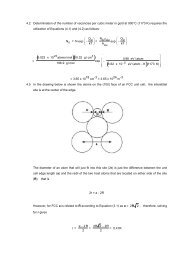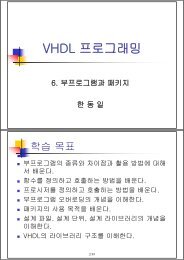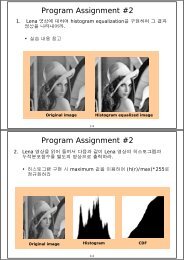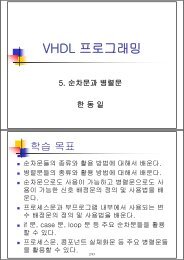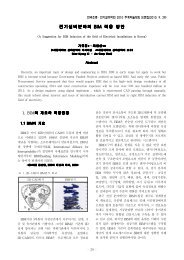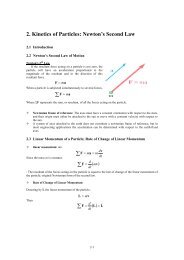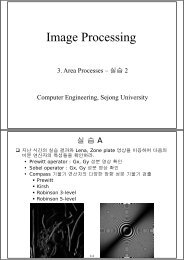Internal generation of waves for extended Boussinesq equations
Internal generation of waves for extended Boussinesq equations
Internal generation of waves for extended Boussinesq equations
You also want an ePaper? Increase the reach of your titles
YUMPU automatically turns print PDFs into web optimized ePapers that Google loves.
Ž .<br />
Coastal Engineering 42 2001 155–162<br />
www.elsevier.comrlocatercoastaleng<br />
<strong>Internal</strong> <strong>generation</strong> <strong>of</strong> <strong>waves</strong> <strong>for</strong> <strong>extended</strong> <strong>Boussinesq</strong> <strong>equations</strong><br />
Changhoon Lee a,) , Yong-Sik Cho b , Kidai Yum c<br />
a Department <strong>of</strong> CiÕil and EnÕironmental Engineering, Sejong UniÕersity, 98 Kunja-dong, Kwangjin-ku, Seoul, 143-747, South Korea<br />
b Department <strong>of</strong> CiÕil Engineering, Hanyang UniÕersity, 17 Haengdang-dong, Songdong-ku, Seoul 133-791, South Korea<br />
c Coastal and Harbor Engineering Research Center, Korea Ocean Research and DeÕelopment Institute, Ansan P.O. Box 29,<br />
Seoul 425-600, South Korea<br />
Received 13 August 1999; received in revised <strong>for</strong>m 17 August 2000; accepted 12 September 2000<br />
Abstract<br />
It is studied whether the mass transport or energy transport is the proper viewpoint <strong>for</strong> internally generating <strong>waves</strong> in the<br />
<strong>extended</strong> <strong>Boussinesq</strong> <strong>equations</strong> <strong>of</strong> Nwogu wJ. Waterw., Port, Coastal Ocean Eng. 119 Ž 1993. 618–638 x. Numerical solutions<br />
<strong>of</strong> the <strong>Boussinesq</strong> <strong>equations</strong> with the internal <strong>generation</strong> <strong>of</strong> sinusoidal <strong>waves</strong> show that the energy transport approach yields<br />
the required wave amplitude properly while the mass transport approach yields wave amplitude different from the required<br />
one by the ratio <strong>of</strong> phase velocity to energy velocity. The <strong>waves</strong> which pass through the wave <strong>generation</strong> point do not cause<br />
any numerical distortion while the incident <strong>waves</strong> are generated. The technique <strong>of</strong> internal <strong>generation</strong> <strong>of</strong> <strong>waves</strong> shows its<br />
capability <strong>of</strong> generating nonlinear cnoidal <strong>waves</strong> as well as linear sinusoidal <strong>waves</strong>. q 2001 Elsevier Science B.V. All rights<br />
reserved.<br />
Keywords: Extended <strong>Boussinesq</strong> <strong>equations</strong>; <strong>Internal</strong> <strong>generation</strong> <strong>of</strong> <strong>waves</strong>; Mass transport; Energy transport; Numerical test<br />
1. Introduction<br />
The propagation <strong>of</strong> water <strong>waves</strong> is a dynamic<br />
phenomenon which gives the human beings happiness<br />
some time or a disaster other time. Identification<br />
<strong>of</strong> the physical behavior <strong>of</strong> water <strong>waves</strong> is still<br />
ongoing research topic. The <strong>Boussinesq</strong> <strong>equations</strong><br />
are known to predict the random and nonlinear behavior<br />
<strong>of</strong> water <strong>waves</strong> with high accuracy especially<br />
in shallow water. The <strong>equations</strong> were developed<br />
firstly by <strong>Boussinesq</strong> Ž 1872.<br />
<strong>for</strong> <strong>waves</strong> over a constant<br />
water depth and later were <strong>extended</strong> to variable<br />
water depths by Peregrine Ž 1967 .. The <strong>Boussinesq</strong><br />
) Corresponding author. Fax: q82-2-3408-3332.<br />
Ž .<br />
E-mail address: clee@sejong.ac.kr C. Lee .<br />
<strong>equations</strong>, which are composed <strong>of</strong> the continuity<br />
equation and x- and y-momentum <strong>equations</strong>, are<br />
derived based on two parameters, the dispersiveness<br />
<strong>of</strong> the relative water depth kh Žk is the wave number<br />
and h is the water depth.<br />
and the nonlinearity <strong>of</strong> the<br />
relative wave amplitude arh Ža is the wave amplitude.<br />
and on the assumption <strong>of</strong> kh
156<br />
( )<br />
C. Lee et al.rCoastal Engineering 42 2001 155–162<br />
superiority <strong>of</strong> the <strong>Boussinesq</strong> <strong>equations</strong> to other wave<br />
<strong>equations</strong> has been strengthened. Two types <strong>of</strong> the<br />
<strong>extended</strong> <strong>Boussinesq</strong> <strong>equations</strong> have been developed.<br />
The first type was developed by adding correction<br />
terms to the momentum <strong>equations</strong> in order to get the<br />
linear dispersion relation close to the exact one<br />
Ž Madsen et al., 1991; Madsen and Sorensen, 1992 ..<br />
The second type was developed by using the horizontal<br />
velocities at a certain level instead <strong>of</strong> the<br />
depth-averaged velocities in order to get the linear<br />
dispersion relation close to the exact one ŽNwogu,<br />
1993 .. The model <strong>of</strong> Nwogu, which is accurate to<br />
OŽŽ kh . 2 , arh ., was developed in a different <strong>for</strong>m<br />
with the velocity potential instead <strong>of</strong> the particle<br />
velocity by Chen and Liu Ž 1995 .. It was <strong>extended</strong> to<br />
OŽŽ kh . 2 , Ž arh. 3 Ž kh. 2 . by Wei et al. Ž 1995 ., and<br />
further to OŽŽ kh . 4 , Ž arh. 5 Ž kh. 4 . by Madsen and<br />
Schaffer ¨ Ž 1998 .. It was also <strong>extended</strong> to consider the<br />
case <strong>of</strong> <strong>waves</strong> on a current with OŽŽ kh . 2 , arh.<br />
by<br />
Chen et al. Ž 1998 ..<br />
The hyperbolic-type wave <strong>equations</strong> may be used<br />
to solve a lot <strong>of</strong> engineering problems such as design<br />
wave height or harbor resonance because the behavior<br />
<strong>of</strong> water <strong>waves</strong> is predicted in real time and the<br />
reflection conditions at coastal structures can be<br />
specified at will. The solution process <strong>of</strong> the hyperbolic-type<br />
wave <strong>equations</strong> starts with a calm state <strong>of</strong><br />
surface elevations and continues until the wave energy,<br />
which is made at <strong>of</strong>fshore boundaries, propagates<br />
to the region <strong>of</strong> interest. The wave energy<br />
would reflect against the coastal structures and propagate<br />
back to the <strong>of</strong>fshore boundaries. The open<br />
boundary conditions may be specified perfectly if the<br />
wave energy which is reflected back to the <strong>of</strong>fshore<br />
boundaries is transmitted without any re-reflection<br />
back to the computational domain. This is possible<br />
by generating <strong>waves</strong> internally at a wave <strong>generation</strong><br />
line which is placed inside the computational domain<br />
while a sponge layer is placed at <strong>of</strong>fshore boundaries<br />
Ž Larsen and Dancy, 1983 .. Then the wave which is<br />
generated at the wavemaker would propagate in both<br />
directions from the wave <strong>generation</strong> line and some<br />
wave energy which is reflected against the structure<br />
would pass through the wave <strong>generation</strong> line without<br />
any numerical distortion, and further be absorbed in<br />
the sponge layer at the <strong>of</strong>fshore boundaries.<br />
There are two different viewpoints related to the<br />
internal wave <strong>generation</strong>. One is the viewpoint <strong>of</strong><br />
mass transport that the water mass which is generated<br />
at the wave <strong>generation</strong> line transports in phase<br />
velocity. The viewpoint is applied in the <strong>Boussinesq</strong><br />
<strong>equations</strong> <strong>of</strong> Peregrine Ž Larsen and Dancy, 1983.<br />
and<br />
the mild-slope <strong>equations</strong> <strong>of</strong> Copeland Ž 1985. ŽMad-<br />
sen and Larsen, 1987; Yoon et al., 1996 .. The other<br />
is the viewpoint <strong>of</strong> energy transport that the wave<br />
energy which is generated at the wave <strong>generation</strong><br />
line transports in energy velocity. This viewpoint is<br />
applied in the mild-slope <strong>equations</strong> <strong>of</strong> Radder and<br />
Dingemans Ž 1985. and Copeland ŽSuh et al., 1997;<br />
Lee and Suh, 1998 .. Lee and Suh found that application<br />
<strong>of</strong> the mass transport approach to the mild-slope<br />
<strong>equations</strong> <strong>of</strong> Radder and Dingemans yields improper<br />
wave energy. They also found that, in the case <strong>of</strong><br />
<strong>equations</strong> <strong>of</strong> Copeland, two viewpoints <strong>of</strong> the mass<br />
transport and energy transport give the same results<br />
because the energy velocity is the phase velocity.<br />
Further, they implied that, in the case <strong>of</strong> <strong>equations</strong> <strong>of</strong><br />
Peregrine, the mass transport approach might be<br />
applied properly because the phase velocity in shallow<br />
water is almost the same as the energy velocity.<br />
In other words, it would be problematic to use the<br />
viewpoint <strong>of</strong> mass transport in deeper water.<br />
In this study, it will be found whether the mass<br />
transport or energy transport approach yields a proper<br />
wave energy <strong>for</strong> internally generating <strong>waves</strong> in the<br />
<strong>Boussinesq</strong> <strong>equations</strong> <strong>of</strong> Nwogu. In Section 2, the<br />
approaches <strong>of</strong> the mass transport and energy transport<br />
are described and the phase and energy velocities<br />
are derived. In Section 3, in a horizontally<br />
one-dimensional domain, a finite difference method<br />
is used to discretize the <strong>equations</strong> <strong>of</strong> Nwogu. Then,<br />
the cnoidal <strong>waves</strong> and sinusoidal <strong>waves</strong> are generated<br />
internally with two different approaches. Finally,<br />
concluding remarks are made in Section 4.<br />
2. Mass transport and energy transport<br />
The <strong>extended</strong> <strong>Boussinesq</strong> <strong>equations</strong> <strong>of</strong> Nwogu<br />
Ž 1993.<br />
are written as:<br />
Eh z 2 a h 2<br />
q=P Ž hqh. u q=P y h= Ž =Pu.<br />
Et 2 6<br />
ž /<br />
½ž /<br />
h<br />
q z q h= =P Ž hu. s0 Ž 1.<br />
2<br />
a 5
( )<br />
C. Lee et al.rCoastal Engineering 42 2001 155–162 157<br />
Eu<br />
q Ž uP= . uqg=h<br />
Et<br />
a½ ž / ž / 5<br />
za<br />
Eu Eu<br />
qz = =P q= =P h s0.<br />
2 Et Et<br />
Ž 2.<br />
In Eqs. Ž. 1 and Ž. 2 , h is the water surface elevation,<br />
u is the horizontal velocity vector at a certain<br />
elevation <strong>of</strong> zsz a, h is the mean water depth, g is<br />
the gravitational acceleration, = is the horizontal<br />
gradient operator, and asŽ z .<br />
arh 2 r2qzarh. In<br />
this study, asy0.4 is used which gives zarhs<br />
y0.55.<br />
Waves are generated internally by adding the<br />
value <strong>of</strong> h ) to the computed surface elevation h at<br />
the wave <strong>generation</strong> line at each time step. The value<br />
<strong>of</strong> h ) is given by:<br />
° I<br />
CDt<br />
2h cosu , mass transport<br />
) ~ D x<br />
h s , Ž 3.<br />
CeDt<br />
I<br />
¢ 2h cosu , energy transport<br />
D x<br />
where h I is the water surface elevation <strong>of</strong> incident<br />
<strong>waves</strong>, C and Ce<br />
are the phase and energy velocities<br />
<strong>of</strong> incident <strong>waves</strong>, respectively, u is the angle <strong>of</strong><br />
wave rays from the x-axis, D x is the grid size in the<br />
x-axis, and Dt is the time step. The wave <strong>generation</strong><br />
line is assumed to be parallel to the y-axis.<br />
The phase velocity and energy velocity <strong>of</strong> <strong>waves</strong><br />
can be obtained analytically using the geometric<br />
optics approach. In the case that water depths are<br />
constant and the nonlinear terms are ignored, differentiating<br />
Eq. Ž. 1 in space, differentiating equation<br />
Eq. Ž. 2 in time, and eliminating h from two resultant<br />
<strong>equations</strong> yield the following equation as,<br />
E 2 u<br />
ygh= =Pu Ž .<br />
Et 2<br />
ž /<br />
1<br />
y aq<br />
3<br />
Ž . 4<br />
3<br />
gh= =P = =Pu<br />
ž /<br />
E 2 u<br />
2<br />
qa h = =P s0. Ž 4<br />
2<br />
.<br />
Et<br />
When we consider the wave field along the direction<br />
<strong>of</strong> wave ray, i.e., s-direction, the wave field may<br />
be analyzed in one dimension. Then, the particle<br />
velocity u may be defined as,<br />
usAe ic , Ž 5.<br />
where A is the amplitude <strong>of</strong> the velocity and the<br />
phase function c has the following relations with<br />
the wave number k and angular frequency v as,<br />
Ec Ec<br />
ks , vsy . Ž 6.<br />
Es Et<br />
Substituting Eq. Ž. 5 into Eq. Ž. 4 and rearranging<br />
the real part <strong>of</strong> the resultant equation to the order <strong>of</strong><br />
OŽ.<br />
1 yield the phase velocity C as:<br />
) ž /<br />
2<br />
1<br />
2<br />
1y aq Ž kh<br />
v<br />
.<br />
3<br />
Cs s gh . Ž 7.<br />
k<br />
1ya Ž kh.<br />
Substituting Eq. Ž. 5 into Eq. Ž. 4 , rearranging the<br />
imaginary part <strong>of</strong> the resultant equation to the order<br />
<strong>of</strong> OŽ E ArEt, E ArEs ., and further multiplying by A<br />
yield the transport equation <strong>for</strong> wave energy given<br />
as,<br />
E A 2 E A 2<br />
qCe<br />
s0, Ž 8.<br />
Et Es<br />
where the energy velocity Ce<br />
is given by:<br />
2<br />
Ž kh.<br />
Ce sC 1y .<br />
1<br />
2 2<br />
3½1yž aq<br />
/ Ž kh. 51ya Ž kh.<br />
4<br />
3<br />
Ž 9.<br />
It should be noted that the energy velocity Ce<br />
is<br />
the same as the group velocity Cg<br />
sEvrEk obtained<br />
by Nwogu Ž 1993 ..<br />
3. Numerical experiment<br />
Numerical experiments are conducted in horizontally<br />
one-dimensional cases. The governing <strong>equations</strong><br />
are discretized in time using the predictor-cor-
158<br />
( )<br />
C. Lee et al.rCoastal Engineering 42 2001 155–162<br />
rector scheme. Both cnoidal and sinusoidal <strong>waves</strong><br />
are generated internally from two viewpoints <strong>of</strong> the<br />
mass transport and energy transport.<br />
3.1. Finite difference method<br />
Sponge layers are placed at boundaries in order to<br />
minimize wave reflections from the boundaries. Eqs.<br />
Ž. 1 and Ž. 2 can be written in a horizontally one-dimensional<br />
domain as,<br />
½ž /<br />
Eh E E z 2 a h 2 E 2 u<br />
q Ž hqh. u4<br />
q y h<br />
2<br />
Et Ex Ex 2 6 Ex<br />
ž /<br />
h E 2<br />
q z q h Ž hu. s0 Ž 10.<br />
2 Ex<br />
a 2 5<br />
½ ž / 5<br />
Eu 1 Eu 2 Eh za<br />
E 3 u E 2 Eu<br />
q qg qza q h<br />
2 2<br />
Et 2 Ex Ex 2 Ex Et Ex Et<br />
qv Dus0, s<br />
Ž 11.<br />
where,<br />
° d r S<br />
~ e y1 , inside sponge layer<br />
Ds s ey1<br />
. Ž 12.<br />
¢ 0, outside sponge layer<br />
In Eq. Ž 12 ., Ss2.5 L Ž L is the wavelength.<br />
is the<br />
thickness <strong>of</strong> the sponge layer and d is the distance<br />
from the starting point <strong>of</strong> the sponge layer.<br />
The variables h and u in Eqs. Ž 10. and Ž 11.<br />
iy1r2 i<br />
are placed in a staggered grid system where the<br />
subscript i denotes the spatial grid point. The firstorder<br />
spatial derivative terms in Eqs. Ž 10. and Ž 11.<br />
are discretized to OŽŽ D x . 4 .. Both the second-and<br />
third-order spatial derivative terms in Eq. Ž 10.<br />
are<br />
discretized to OŽŽ D x. 2 . and the second-order spatial<br />
derivative terms in Eq. Ž 11.<br />
are discretized to<br />
OŽŽ D x . 4 ..<br />
The time derivative terms in Eqs. Ž 10. and Ž 11.<br />
are discretized to OŽŽ Dt. 2 . using the predictor-corrector<br />
method. Eq. Ž 10.<br />
is discretized explicitly between<br />
the n-th and Ž nq1r2.<br />
-th time steps to get the<br />
p<br />
surface elevation h at the Ž nq1r2.<br />
-th time step.<br />
The superscript p in h stands <strong>for</strong> the predictor. Eq.<br />
Ž 10.<br />
is discretized again implicitly between the n-th<br />
and Ž nq1r2.<br />
-th time steps to get the surface elevanq1r2<br />
tion h at the Ž nq1r2.<br />
-th time step. At this<br />
time, the surface elevation h and the particle velocity<br />
u in the spatial derivatives are replaced by h p<br />
and Žu n qu nq1 . r2, respectively. And then, Eq. Ž 11.<br />
is discretized between the n-th and Ž nq1.<br />
-th time<br />
steps. At this time, the surface elevation h is replaced<br />
by h nq1r2 . The resulting equation gives a<br />
hepta-diagonal matrix <strong>of</strong> u nq1 given as:<br />
Au nq1 qBu nq1 qCu nq1 qDu nq1 qEu nq1<br />
i iy3 i iy2 i iy1 i i i iq1<br />
qFiuiq2 nq1 qGu i iq3 nq1 sH i , Ž 13.<br />
where A i, ..., Hi<br />
are coefficients <strong>of</strong> h n and u n .<br />
Using the method <strong>of</strong> LU decomposition ŽPress et al.,<br />
1992 ., Eq. Ž 13.<br />
is solved to get the particle velocity<br />
nq1<br />
u . Again, Eq. Ž 10.<br />
is discretized between the n-th<br />
and Ž nq1.<br />
-th time steps. At this time, the particle<br />
velocity u is replaced by Žu n qu nq1 . r2 and the<br />
surface elevation h in EŽ hqh. u4<br />
i<br />
rEx is replaced<br />
Ž<br />
n nq1 n nq1<br />
by h qh qh qh .<br />
iq1r2 iq1r2 iy1r2 iy1r2 r4. The re-<br />
sulting equation gives a penta-diagonal matrix given<br />
as,<br />
ah nq1 qbh nq1 qgh nq1 qdh nq1<br />
i iy5r2 i iy3r2 i iy1r2 i iq1r2<br />
qeihiq3r2 nq1 ss i , Ž 14.<br />
where a i, ..., si<br />
are coefficients <strong>of</strong> h n , u n , and<br />
u nq1 . Using the method <strong>of</strong> LU decomposition, Eq.<br />
Ž .<br />
nq1<br />
14 is solved to get the surface elevation h .<br />
Waves are generated smoothly by multiplying<br />
Ž . Ž .<br />
)<br />
tanh nDtrT T is the wave period to h in Eq.<br />
Ž. 3 . At both the left and right boundaries, a reflective<br />
boundary condition is specified as:<br />
u nq1 s0, u nq1 s0, h nq1 sh nq1 ,<br />
1 Iy1 1r2 3r2<br />
h nq1 sh nq1 , Ž 15.<br />
Iy1r2<br />
Iy3r2<br />
where is1 and isIy1 denote the points <strong>of</strong> the<br />
left and right boundaries, respectively. The grid size<br />
is chosen as D xsLr20 in order to get sufficient<br />
spatial resolution. The time step is chosen so that the<br />
Courant number is CrsCe<br />
DtrD xs0.2 and a sta-<br />
ble solution is guaranteed.
( )<br />
C. Lee et al.rCoastal Engineering 42 2001 155–162 159<br />
3.2. Uni-directional regular waÕes<br />
Firstly, cnoidal <strong>waves</strong> are generated internally<br />
with the condition <strong>of</strong> Larsen and Dancy Ž 1983 .. The<br />
computational domain consists <strong>of</strong> an inner domain <strong>of</strong><br />
400 m and a sponge layer at the right boundary. The<br />
wave <strong>generation</strong> point is located at the mid-point <strong>of</strong><br />
the inner computational domain. The wave period is<br />
Ts20 s, the wave height is Hs0.5 m, and the<br />
water depth is hs10 m, which gives the wavelength<br />
Ls195 m, the relative water depth khs<br />
0.1p , the wave steepness arhs0.025, and the<br />
Ursell number U Ž . Ž .<br />
r s arh r kh<br />
2 s0.24. Both the<br />
mass transport and energy transport approaches are<br />
used to generate <strong>waves</strong>.<br />
Fig. 1 shows the surface elevations at time between<br />
ts10T and ts11T with an interval <strong>of</strong><br />
Tr10. Good agreement is observed between this<br />
figure and Fig. 2 <strong>of</strong> Larsen and Dancy Ž 1983 .. This<br />
is because, in shallow water with khs0.1p , the<br />
<strong>equations</strong> <strong>of</strong> Nwogu Ž 1993.<br />
are almost the same as<br />
those <strong>of</strong> Peregrine Ž 1967 .. Numerical solutions <strong>of</strong> the<br />
wave amplitude by the mass transport approach are<br />
3% larger than those by the energy transport approach<br />
which matches the ratio <strong>of</strong> CrCe<br />
s1.03 <strong>for</strong><br />
khs0.1p.<br />
In Fig. 1, the incident <strong>waves</strong> generated at the<br />
wave <strong>generation</strong> point propagate both directions<br />
while the <strong>waves</strong> reflected from the left boundary<br />
pass through the wave <strong>generation</strong> point with no<br />
serious numerical distortion. Such good work <strong>for</strong><br />
internally generating <strong>waves</strong> wouldn’t be seen if the<br />
unstaggered grid scheme is used in the <strong>Boussinesq</strong><br />
<strong>equations</strong> <strong>of</strong> Nwogu Ž Wei et al., 1999 .. This is<br />
probably because the unstaggered grid scheme may<br />
result in distortion <strong>of</strong> the solution. Lee and Suh<br />
Ž 1998.<br />
found that the use <strong>of</strong> the unstaggered grid<br />
scheme in the time-dependent mild-slope <strong>equations</strong><br />
<strong>of</strong> Radder and Dingemans Ž 1985.<br />
is all right <strong>for</strong> the<br />
internal wave <strong>generation</strong>. This is probably because<br />
the model <strong>equations</strong> are linear and the distortion <strong>of</strong><br />
the solution is not serious. However, the resolved<br />
wave height was found to fluctuate around the exact<br />
solution due to the use <strong>of</strong> the unstaggered grid<br />
Fig. 1. Surface elevations <strong>of</strong> internally generated cnoidal <strong>waves</strong>; solid linesenergy transport, dashed linesmass transport.
160<br />
( )<br />
C. Lee et al.rCoastal Engineering 42 2001 155–162<br />
scheme. In the study <strong>of</strong> Lee and Suh, the phenomenon<br />
<strong>of</strong> such fluctuations is not observed <strong>for</strong> the<br />
<strong>equations</strong> <strong>of</strong> Copeland Ž 1985 ., which is because the<br />
variables are placed at the staggered grids.<br />
In Fig. 1, the wave heights are not very constant<br />
along the channel which is also found in Fig. 2 <strong>of</strong><br />
Larsen and Dancy. This is probably because, firstly,<br />
the discretization <strong>of</strong> spatial derivative terms on<br />
high-order stencils may result in distortion <strong>of</strong> the<br />
solution and, secondly, the induced numerical noise<br />
is not absorbed perfectly at the right boundary and<br />
thus reflected back to the computational domain.<br />
Secondly, sinusoidal <strong>waves</strong> are generated internally<br />
on a flat bottom while the relative water depth<br />
varies from shallow water Ž khs0.05p . to deep<br />
water Ž khs5p .. The wave period is Ts10 s, and<br />
the wave steepness is arhs0.01. Both the mass<br />
transport and energy transport approaches are used.<br />
The computational domain consists <strong>of</strong> an inner domain<br />
<strong>of</strong> 8 L and sponge layers at both the right and<br />
left boundaries. The wave <strong>generation</strong> point is located<br />
at the mid-point <strong>of</strong> the inner computational domain.<br />
Wave amplitudes are measured at points between L<br />
and 3L to the right <strong>of</strong> the wave <strong>generation</strong> point at<br />
the time ts10T.<br />
Fig. 2 shows the ratio <strong>of</strong> measured to incident<br />
wave amplitudes versus relative water depth. The<br />
energy transport approach gives the measured wave<br />
amplitude almost equal to the incident wave amplitude,<br />
while the mass transport approach gives the<br />
measured one different from the incident one by the<br />
ratio <strong>of</strong> approximately CrC e. This implies that, <strong>for</strong><br />
the <strong>Boussinesq</strong> <strong>equations</strong> <strong>of</strong> Nwogu, the internal<br />
<strong>generation</strong> <strong>of</strong> <strong>waves</strong> can be made properly by the<br />
energy transport approach rather than the mass transport<br />
approach. The value <strong>of</strong> khs5p is far beyond<br />
the traditional deep water limit <strong>of</strong> khsp , beyond<br />
which the <strong>equations</strong> <strong>of</strong> Nwogu yield large errors in<br />
the dispersion. Although there is a point in going to<br />
large value <strong>of</strong> kh <strong>for</strong> a wide range demonstration<br />
that Ce<br />
works better than C, the <strong>equations</strong> are<br />
useless <strong>for</strong> the value <strong>of</strong> kh much larger than p.<br />
Fig. 2. Ratio <strong>of</strong> amplitude <strong>of</strong> internally generated sinusoidal <strong>waves</strong> to target one vs. relative water depth; osenergy transport, xsmass<br />
transport, solid linesCrC . e
( )<br />
C. Lee et al.rCoastal Engineering 42 2001 155–162 161<br />
Fig. 3. Normalized surface elevations <strong>of</strong> internally generated cnoidal <strong>waves</strong> with different heights using energy transport approach; solid<br />
linesnumerical solution, dashed linesexact solution.<br />
Thirdly, cnoidal <strong>waves</strong> with different heights are<br />
internally generated in shallow water using the energy<br />
transport approach. The wave period is Ts20 s<br />
and the water depth is hs10 m. The wave heights<br />
are Hs0.1, 0.5, 3 m, so the Ursell numbers are<br />
Ur<br />
s0.05, 0.24, 1.44, respectively. The computa-<br />
tional domain consists <strong>of</strong> an inner domain <strong>of</strong> 8 L and<br />
sponge layers at both the right and left boundaries.<br />
The wave <strong>generation</strong> point is located at the mid-point<br />
<strong>of</strong> the inner computational domain.<br />
Fig. 3 shows a comparison <strong>of</strong> the numerical solution<br />
<strong>of</strong> the surface elevation to the exact solution at<br />
the time ts10T. In the figure, the horizontal distance<br />
is normalized by the wavelength obtained by<br />
the linearized dispersion relation. For the case <strong>of</strong><br />
Hs0.1 m, the <strong>waves</strong> simulated are almost the same<br />
as the sinusoidal <strong>waves</strong>. Good agreement is observed<br />
between the numerical solution to the exact one<br />
which shows the capability <strong>of</strong> the present technique<br />
in generating nonlinear <strong>waves</strong> as well as linear sinusoidal<br />
<strong>waves</strong>. As the wave height is larger, the wave<br />
crest is steeper, the trough is flatter, the wavelength<br />
is longer, and the phase speed is faster. These are the<br />
characteristics <strong>of</strong> nonlinear shallow-water <strong>waves</strong>.<br />
4. Conclusion<br />
It is studied to find out whether the mass transport<br />
or the energy transport is a proper approach <strong>for</strong><br />
internally generating <strong>waves</strong> in the <strong>extended</strong> <strong>Boussinesq</strong><br />
<strong>equations</strong> <strong>of</strong> Nwogu Ž 1993 .. The geometric<br />
optics approach is used to get analytically the phase<br />
and energy velocities <strong>for</strong> the linearized <strong>Boussinesq</strong><br />
<strong>equations</strong> <strong>of</strong> Nwogu. The variables <strong>of</strong> the surface<br />
elevation and the particle velocity in the <strong>equations</strong> <strong>of</strong><br />
Nwogu are placed in a staggered grid system. Sponge<br />
layers are placed at the boundaries in order to minimize<br />
wave reflections from the boundaries.<br />
In a horizontally one-dimensional domain, both<br />
the cnoidal and sinusoidal <strong>waves</strong> are generated inside<br />
the computational domain. It is found that the
162<br />
( )<br />
C. Lee et al.rCoastal Engineering 42 2001 155–162<br />
<strong>waves</strong> which pass through the wave <strong>generation</strong> point<br />
cause no serious numerical distortion while the incident<br />
<strong>waves</strong> are generated at the point. The numerical<br />
results <strong>of</strong> internal <strong>generation</strong> <strong>of</strong> sinusoidal <strong>waves</strong>,<br />
with different water depths ranging from shallow to<br />
deep waters, show that the energy transport approach<br />
gives wave amplitudes properly. However, the mass<br />
transport approach gives wave amplitudes different<br />
from the desired ones by the ratio <strong>of</strong> phase to energy<br />
velocities. The technique <strong>of</strong> internal <strong>generation</strong> <strong>of</strong><br />
<strong>waves</strong> shows the capability <strong>of</strong> generating nonlinear<br />
cnoidal <strong>waves</strong> as well as linear sinusoidal <strong>waves</strong>.<br />
Although the numerical experiment supports that the<br />
energy transport is a proper approach to internally<br />
generating <strong>waves</strong> in the <strong>extended</strong> <strong>Boussinesq</strong> <strong>equations</strong>,<br />
a theoretical investigation would be much<br />
valuable.<br />
Acknowledgements<br />
The first author wishes to acknowledge the financial<br />
support <strong>of</strong> the Korea Science and Engineering<br />
Foundation Ž no. 2000-1-31100-001-3.<br />
during the visit<br />
<strong>of</strong> the University <strong>of</strong> Delaware. The second author<br />
wishes to acknowledge the financial support <strong>of</strong> the<br />
Korea Science and Engineering Foundation Žno.<br />
1999-2-311-005-3 ..<br />
References<br />
<strong>Boussinesq</strong>, J.V., 1872. Theorie ´ des ondes et des remous qui se<br />
propaent le long d’un canal rectangulaire horizontal, en communiquant<br />
au liquide contenu dans ce canal des vitesses<br />
sensiblement pareilles de la surface au dond. J. Math. Pures<br />
Appliq. 17, 55–108.<br />
Chen, Y., Liu, P.L.-F., 1995. Modified <strong>Boussinesq</strong> <strong>equations</strong> and<br />
associated parabolic models <strong>for</strong> water wave propagation. J.<br />
Fluid Mech. 288, 351–388.<br />
Chen, Q., Madsen, P.A., Schaffer, ¨ H.A., Basco, D.R., 1998.<br />
Wave–current interaction based on an enhanced <strong>Boussinesq</strong><br />
approach. Coastal Eng. 33, 11–39.<br />
Copeland, G.J.M., 1985. A practical alternative to the Amild-slopeB<br />
wave equation. Coastal Eng. 9, 125–149.<br />
Larsen, J., Dancy, H., 1983. Open boundaries in short wave<br />
simulations—a new approach. Coastal Eng. 7, 285–297.<br />
Lee, C., Suh, K.D., 1998. <strong>Internal</strong> <strong>generation</strong> <strong>of</strong> <strong>waves</strong> <strong>for</strong> timedependent<br />
mild-slope <strong>equations</strong>. Coastal Eng. 34, 35–57.<br />
Madsen, P.A., Larsen, J., 1987. An efficient finite-difference<br />
approach to the mild-slope equation. Coastal Eng. 11, 329–351.<br />
Madsen, P.A., Schaffer, ¨ H.A., 1998. Higher-order <strong>Boussinesq</strong>-type<br />
<strong>equations</strong> <strong>for</strong> surface gravity <strong>waves</strong>: derivation and analysis.<br />
Philos. Trans. R. Soc. London A 356, 3123–3184.<br />
Madsen, P.A., Sorensen, O.R., 1992. A new <strong>for</strong>m <strong>of</strong> the <strong>Boussinesq</strong><br />
<strong>equations</strong> with improved linear dispersion characteristics:<br />
Part 2. A slowly varying bathymetry. Coastal Eng. 18, 183–<br />
204.<br />
Madsen, P.A., Murray, R., Sorensen, O.R., 1991. A new <strong>for</strong>m <strong>of</strong><br />
the <strong>Boussinesq</strong> <strong>equations</strong> with improved linear dispersion<br />
characteristics. Coastal Eng. 15, 371–388.<br />
Nwogu, O., 1993. Alternative <strong>for</strong>m <strong>of</strong> <strong>Boussinesq</strong> <strong>equations</strong> <strong>for</strong><br />
nearshore wave propagation. J. Waterw., Port, Coastal Ocean<br />
Eng. 119, 618–638.<br />
Peregrine, D.H., 1967. Long <strong>waves</strong> on a beach. J. Fluid Mech. 27,<br />
815–827.<br />
Press, W.H., Teukolsky, S.A., Vetterling, W.T., Flannery, B.P.,<br />
1992. Numerical Recipes in Fortran: The Art <strong>of</strong> Scientific<br />
Computing. 2nd edn. Cambridge Univ. Press, pp. 42–47.<br />
Radder, A.C., Dingemans, M.W., 1985. Canonical <strong>equations</strong> <strong>for</strong><br />
almost periodic, weakly nonlinear gravity <strong>waves</strong>. Wave Motion<br />
7, 473–485.<br />
Suh, K.D., Lee, C., Park, W.S., 1997. Time-dependent <strong>equations</strong><br />
<strong>for</strong> wave propagation on rapidly varying topography. Coastal<br />
Eng. 32, 91–117.<br />
Wei, G., Kirby, J.T., Grilli, S.T., Subramanya, R., 1995. A fully<br />
nonlinear <strong>Boussinesq</strong> model <strong>for</strong> surface <strong>waves</strong>: Part 1. Highly<br />
nonlinear unsteady <strong>waves</strong>. J. Fluid Mech. 294, 71–92.<br />
Wei, G., Kirby, J.T., Sinha, A., 1999. Generation <strong>of</strong> <strong>waves</strong> in<br />
<strong>Boussinesq</strong> models using a source function method. Coastal<br />
Eng. 36, 271–299.<br />
Yoon, S.B., Lee, J.I., Lee, J.K., Chae, J.W., 1996. Boundary<br />
treatment techniques <strong>of</strong> numerical model <strong>for</strong> the prediction <strong>of</strong><br />
harbor oscillation. J. Korean Soc. Civ. Eng. 16, 53–62, ŽIn<br />
Korean ..



